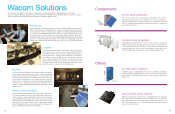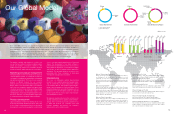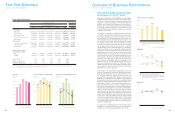Wacom 2010 Annual Report Download - page 18
Download and view the complete annual report
Please find page 18 of the 2010 Wacom annual report below. You can navigate through the pages in the report by either clicking on the pages listed below, or by using the keyword search tool below to find specific information within the annual report.
Notes to Consolidated Financial Statements
(ii)
Securities for which market price or quotations are not available.
(iii) Redemption schedule
The redemption schedule of held-to-maturity debt securities as of March 31, 2009
Investment securities of ¥35,077 thousand ($377
thousand) on the consolidated balance sheet for the
fiscal year ended March 31, 2010 do not have market
prices. And there is no readily available information to
calculate the current market value, thus omitted from
fair market value presentation.
12. Derivatives:
All derivative transactions are entered into to hedge
foreign currency exposures within the Company’s
business. Accordingly, the market risk in these
derivatives is offset by opposite movements in the
value of hedged assets or liabilities. The Company
does not hold derivatives for trading or speculative
purposes. Because the counterparties to these
derivatives are limited to major international finance
institutions, the Company does not anticipate any
losses arising from credit risk.
Derivative transactions entered into by the Company
have been executed in accordance with internal
policies, which regulate the authorization and credit
limit amount of transactions.
The amount of the derivative contracts does not
necessarily indicate the significance of the risk.
Certain information on outstanding derivative contracts
is shown below.
b) Financial instruments per which there is no readily
available information are reported at their carrying
value as of March 31, 2010.
These financial instruments do not have market prices.
And there is no readily available information to calcu-
late the current market value, thus omitted from fair
market value presentation.
c) Redemption schedule of financial instruments after
year ended March 31, 2010.
(Additional information)
“Accounting Standard for Financial Instruments”
(Accounting Standards Board of Japan Statement No.
10, issued on March 10, 2008) and “Guidance on
Disclosure of fair value of financial instruments”
(Accounting Standards Board of Japan Guidance No.
19 issued on March 10, 2008) has been adopted
effective for the fiscal year ended March 31, 2010.
11. Investment securities:
Marketable and investment securities:
The following is certain information relating to the
aggregate acquisition cost and market value of securities
in fiscal year 2009.
(i) Held-to-maturity debt securities with fair market value
34
Financial instruments
Unlisted securities
Thousands of yen
¥35,077
Carrying Amount
Financial instruments
Unlisted securities
Thousands of U.S. dollars (Note 1)
$377
Carrying Amount
¥
12,350,113
4,701,126
1,920,657
¥
18,971,896
¥
–
–
–
¥
–
¥
–
–
–
¥
–
¥
–
–
–
¥
–
Thousands of yen
Cash and deposits
Notes and accounts
receivable - trade
Accounts receivable
- other
Total
Due within
one year
Due over one year
to 5 years
Due over 5 years
to 10 years
Due Over
10 years
$132,740
50,528
20,643
$203,911
$
–
–
–
$
–
$
–
–
–
$
–
$
–
–
–
$
–
Thousands of U.S. dollars (Note 1)
Cash and deposits
Notes and accounts
receivable - trade
Accounts receivable
- other
Total
Due within
one year
Due over one year
to 5 years
Due over 5 years
to 10 years
Due Over
10 years
Thousands of yen
March 31, 2009
Securities with fair market value not exceeding
book carrying amount-other:
Book carrying amount
Fair market value
Difference
¥500,000
490,400
(¥9,600)
Thousands of yen
March 31, 2009
Book carrying
amount
Other securities:
Non-marketable equity securities
Other
¥35,277
1,020,000
Thousands of yen
Bonds
(1) Government bonds,
Municipal bonds, etc.
(2) Corporate bonds
(3) Others
Other
Total
Due 2009 Due 2010∼
2013
Due 2014∼
2018
Due after
2019
¥
–
–
500,000
¥
500,000
¥
–
–
–
–
¥
–
¥
–
–
–
–
¥
–
¥
–
–
–
–
¥
–
¥972,403
538,652
89,292
¥1,600,347
¥1,011,634
545,328
85,173
¥1,642,135
(¥39,231)
(6,676)
4,119
(¥41,788)
Foreign exchange forward contracts:
To sell U.S. dollars
To sell Euros
To sell British Pound
Total
Thousands of yen
March 31, 2009
Contract
amount Fair value Unrealized
gain/(loss)
¥1,608,691
455,380
36,438
173,259
¥-
(¥65,060)
5,668
-
(3,505)
(¥62,897)
(¥65,060)
5,668
-
(3,505)
(¥62,897)
Foreign exchange forward contracts:
To sell U.S. dollars
To sell Euros
To sell British Pound
To buy U.S. dollars
Total
Thousands of yen
March 31, 2010
Contract
amount Fair value Unrealized
gain/(loss)
33
10. Financial instruments:
(1) Matters relating to financial instruments-
(a) Policy for financial instruments:
The Group's financing is mainly covered by the
internal fund, in terms of stable and low-cost financ-
ing. However, some short-term financial needs and
working capital needs may be covered by short-term
loan. Long-term financing is also flexible to demand
selecting appropriate vehicle from long-term debt,
issuance of new bond, or issuance of new shares.
Investment of surplus fund is limited in relatively
secure financial instruments with high liquidity and
high credit ratings.
The derivatives are used only for the purpose to avoid
a risk of future currency fluctuations, and any specu-
lative trading is strictly prohibited.
(b) Content of financial instruments and their risks and
risk management scheme:
“Notes and accounts receivable – trade” account as
operating receivables is exposed to credit risk of
customers. Such risks are controlled by the scheme
to keep track of due date and outstanding balance for
every customer, and check customer's credit status
on a regular basis according to the Company’s credit
limit management policy.
“Accounts receivable – other” account mainly con-
sists of operating receivables for supplied materials to
outsourcing production contractors and those
receivables are exposed to credit risk of each con-
tractor. Such risks are controlled by the scheme to
keep track of due date and outstanding balance for
each contractor. Net outstanding balance for such
contractors is relatively small because receivables are
net by payables balance for product purchase to
those contractors.
“Notes and account payable – trade” account as
operating payables is mostly due within one year.
“Short-term loans payable” account is primarily
utilized for financing relating to business transactions.
Liquidity risk for the operating payables and the
short-term loans payable is controlled by a monthly
cash flow forecast.
As to derivative transactions, in order to hedge the
risk of fluctuation in foreign currency monetary assets
and liabilities, the Company uses forward exchange
contracts. For execution and management of deriva-
tive transactions, the finance department is respon-
sible for executing such transactions upon an
approval from authorized personnel in accordance
with the Company’s derivatives transaction policy that
defines approval authority and trading limit of transac-
tions. In addition, to reduce the risk of default on
derivatives trading, the Company limits trading
counterparties to high rated financial institutions only.
(c) Supplementary information concerning the fair
value of financial instruments:
The amount of derivatives contracts in the Notes to
"Derivatives Transaction" is the nominal value of
derivatives contracts or the calculated notional
amount only, and it does not show the size of market
risk relating to the derivative transaction itself.
(2) Fair value of financial instruments-
The following table presents the carrying amounts
recorded in the consolidated balance sheet as of
March 31, 2010, estimated fair values of financial
instruments and the differences. Financial instruments
deemed extremely difficult to calculate the current
market value is not included. (See Note: b)
(*) Derivatives are expressed in net amount of receiv-
ables and payables, and payables in net are expressed
in ( ).
Notes:
a) Matters related to method for calculating market
value of financial instruments and securities and
derivatives transactions.
Assets
(1) Cash and deposits, (2) notes and accounts receiv-
able – trade and (3) accounts receivable - other
Due to expected settlement with in a short period of
time, we estimate that the carrying amount is equiva-
lent to market value.
Liabilities
(1) Notes and accounts payable - trade and (2)
short-term loans payable
Due to expected settlement with in a short period of
time, we estimate that the carrying amount is equiva-
lent to market value.
Derivatives transaction
See Note 12 “Derivatives”.
(1) Cash and deposits
(2) Notes and accounts receivable -
trade
(3) Accounts receivable - other
Total assets
(1) Notes and accounts payable -
trade
(2) Short-term loans payable
Total liabilities
Derivatives (*)
Thousands of yen
Difference
¥ -
-
-
¥ -
-
-
¥ -
¥ -
¥12,350,113
4,701,126
1,920,657
¥18,971,896
4,983,535
600,000
¥5,583,535
(¥62,897)
¥12,350,113
4,701,126
1,920,657
¥18,971,896
4,983,535
600,000
¥5,583,535
(¥62,897)
Carrying Amount
Fair value
(1) Cash and deposits
(2) Notes and accounts receivable -
trade
(3) Accounts receivable - other
Total assets
(1) Notes and accounts payable -
trade
(2) Short-term loans payable
Total liabilities
Derivatives (*)
Thousands of U.S. dollars (Note 1)
Difference
$ -
-
-
$ -
-
-
$ -
$ -
$132,740
50,528
20,643
$203,911
53,563
6,449
$60,012
($676)
$132,740
50,528
20,643
$203,911
53,563
6,449
$60,012
($676)
Carrying Amount
Fair value



















